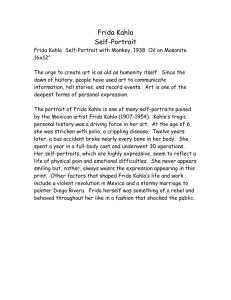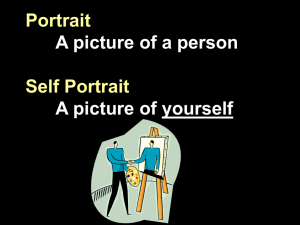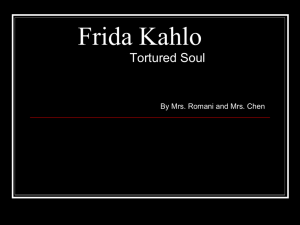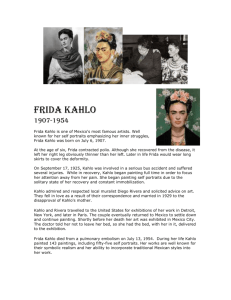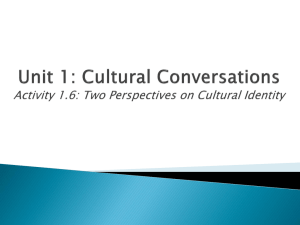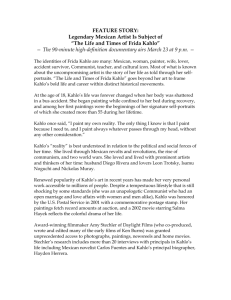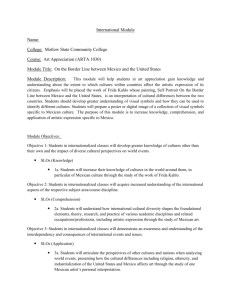Article 2 Frida Kahlo PowerPoint
advertisement
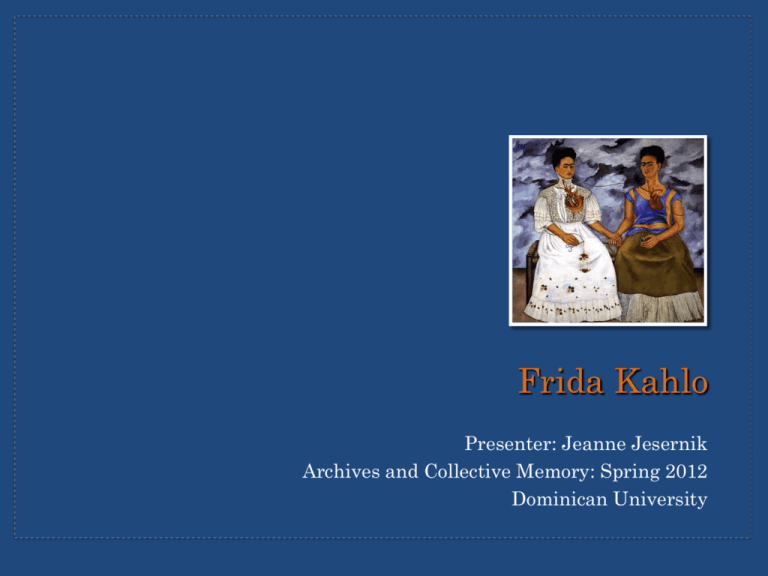
Frida Kahlo Presenter: Jeanne Jesernik Archives and Collective Memory: Spring 2012 Dominican University Frida Kahlo’s Family of Origin Father Guillermo Kahlo [Wilhelm Kahl, a German-Jewish expatriate, of Hungarian descent] Professional Photographer Atheist Had epilepsy Mother Matilde Calderon [Mexican, of Spanish Indian descent] Ran the household Devout Catholic Encouraged Kahlo’s art Encouraged Kahlo’s art Matilde (1898-1951) First wife Maria Cardena died giving birth to third daughter. Second daughter died at birth. Other two girls sent to live in convent. Adriana (1902-1968) Frida (1907-1954) Christina (1905-1964) My Grandparents, My Parents, and I (Family Tree) (1936) The Museum of Modern Art, New York Frida Kahlo : Her Childhood Revisited Born in 1907 (not 1910 as she claimed) as Magdalena Carmen Frieda Kahlo y Calderon in Coyoacán (now an affluent borough near Mexico City; Coyoacán is Nahuatl for “Place of the Coyotes”). She was born three years before the Mexican Revolution (1910-1920), which greatly impacted her life and work Born in La Casa Azul (The Blue House) Lived there with her husband Diego Rivera from 1929-1954. Kahlo died at home. Born with Spina Bifida (Her doctor Leo Eloesser gave this diagnosis in 1930—a fact largely ignored by biographers according to neurologist Valmantas Budrys) At six years old contracted polio (muscular atrophy in her right leg) At fifteen years old entered the Escuela Nacional Preparatoria in Mexico City: A student body of 35 girls and 2,000 boys. She was a member of student political activist group “Las Cachuchas” (the caps; named after their hats) Kahlo and Diego Rivera met briefly while he was painting a mural at the school. He was hired by the Secretario de Educación in support of ideals developed during the Mexican Revolution (part of the Mexican mural renaissance that became known as the Escuela de México: a mix of modern art and indigenous art that rejects European abstract art) La Casa Azul Spanish colonial house that Rivera donated to the government in 1955 Unfinished portrait of Stalin still “in situ” on easel in Kahlo’s studio Pre-Hispanic Jewelry collection and colorful Tehuana costumes Opened as a museum in 1958 Poncho Villa, Leon Trotsky etc. other famous residents of Coyoacán Las Cachuchas or Si Adelita (1927) Private Collection in Mexico. Cubist style painting—popular at that time Si Adelita the name of a popular festival song in Mexico Frida Kahlo : Her Adulthood Revisited In 1925 Kahlo and Alejandro Gomez Arias (her fiancé) were in a near fatal bus accident Kahlo had multiple fractures in her back, right leg, pelvis, and right foot; a dislodged shoulder; and was pierced with a metal rail that impaled her abdomen and uterus Kahlo had thirty operations—many were probably harmful at worst and not necessary at best. In 1953 her right leg was amputated below the knee because of gangrene. She suffered miscarriages, therapeutic abortions, and was frequently confined to her bed over the course of her life In 2012 a UCLA surgical pathologist “diagnosed” Kahlo as having had Asherman’s syndrome (scar tissue in the uterus that prevents successful childbirth). Art historians had been the only ones until this year to discuss why Kahlo could not have a baby Her mother (versus her father) installed a mirror above her bed so Kahlo could paint herself. She also painted portraits of visitors. She began painting seriously at this time—prior to this she was thought to be interested in medicine as a career Henry Ford Hospital or The Flying Bed (Detroit: 1932) The Broken Column (1944) Without Hope (1945) Tree of Hope, Keep Firm (1946) (1946) Kahlo often wore plaster “corsets” and steel braces to support her spine Communist hammer and sickle motif Most photos of Kahlo released 50 years after her death Frida Kahlo : Her Marriages with Diego Rivera 21 year old Kahlo meets Diego Rivera again through a common friend Kahlo approaches Rivera at the Secretaria de Educación and asks for an assessment of her art Rivera supports her painting from this moment forward, without end Kahlo was already a member of the Mexican Communist Party, but her nationalist views diverged from the international concerns of the party. On and off again membership with the party. She and Rivera rejoin in 1954 In 1929, they marry (Kahlo is 22 and Rivera is 43) They divorce in 1939 and remarry in 1940. It is a tumultuous relationship with outside affairs (Kahlo’s are with men and women; Rivera’s affairs include Kahlo’s sister Christina) In 1930, they travel to the U.S. where Rivera is commissioned to paint murals in San Francisco, Detroit, and New York They return to Mexico in 1933 after Rockefeller has Man at the Crossroads painted over Kahlo’s Paintings while in the U.S. Frida and Diego Rivera (1931) Kahlo reinvents herself again with a Spanish Colonial shawl and dress My Birth (1932) [Notes: Madonna owns the original. Kahlo’s mother died during the period Kahlo was painting this] My Dress Hangs There (1932) A cynical depiction of capitalism with her traditional Tehuana dress in the center Diego Rivera’s Man, Controller of the Universe (1934) @ Palacio de Bellas Artes in Mexico City. [Originally Man at the Crossroads commissioned, and destroyed, by Rockefeller because of Lenin image] Depicts Trotsky’s view that society will regulate human reproduction— man controlling an ovulating ovary. Frida Kahlo’s Moses: Nucleus of Creation (1945) Private Collection. [Interpretation of Sigmund Freud’s book Moses the Man and Monotheistic Religion]. Kahlo refutes Rivera’s view and paints images of successful fertilization. She conveys political and social ideas of unrepressed reproductive rights. The third-eye Diego (thought to be symbolic of acuity) is portrayed as the central image, the baby. Kahlo the Self-Portrait Artist? “(Kahlo) moves away from traditional methods of portraiture, to those of assemblage and juxtaposition”—sociologist Joanna Latimer on “in/dividuality” Simplistic “pictorial autobiography” replaced. “(Kahlo) produces a meaningful way to situate herself” Lowe (biographer)-as a Mexican woman and artist, an indigenista etc. Documentation of key moments in her life (Pre-Columbian!) My Nurse and I (1937) Olmec and Teotihuacan imagery (maize, fertility) versus simple interpretation of “wet nurse” scene; and psychoanalytical interpretation of Kahlo’s strained relationship with her ill mother Kahlo the Surrealist? Post WWI (e.g., Salvatore Dalí ) Andre Breton French author of the Surrealist Manifesto claimed Kahlo as one their own— “a ribbon around a bomb”: he arranged her 1938 NY exhibit The Little Deer (1946) Kahlo’s most cited response: “People thought I was a Surrealist. That’s not right. I have never painted my dreams. What I represented was my own reality.” Kahlo the Feminist? Several claims to who rediscovered Kahlo: 1970’s white American feminists versus Chicano muralists in California Theologian Paula Cooey—studies call for multiple readings of Kahlo, beyond a domestic and private sphere, ethnicity, society, religion,& politics need to be considered (e.g., how Kahlo as an atheist uses religious symbols) Self Portrait with Monkeys (1943) Revisionist Feminist Art History: any woman who painted is now studied, since women had once been systematically excluded from art history Kahlo the Mexican Nationalist? Tehuana costume (long skirts and embroidered blouses) reflects Tehuantepec’s matriarchal society and resistance to Aztec domination. In solidarity with European Frida in The Two Fridas ( the bloody scene is symbolic of her disconnect from Rivera) Variety of “nationalisms” in post-Revolutionary Mexico. Kahlo’s folk art (Retablo style—Latin American “oil on tin” religious devotional paintings) Multilayered and flexible identities even evident in the naming of her work: gives more than one name to many of her paintings (The Dream/The Bed; Moses/Nucleus of Creation; The Earth Itself/My Nurse and so on) Self-portrait On the Borderline (1932) The Two Fridas (1939) Kahlo: A National Treasure Rivera established a trust— controversially presided over by his friend, lover, and patron, Dolores Olmedo—to protect the Anahuacalli and Frida Kahlo museums Diego asked “Lola” Olmedo not to open certain spaces in the Casa Azul for a lapse of fifteen years, which she respected. Olmedo died in 2004 The museum board opened the previously closed off sections for the centennial celebration of Frida Kahlo’s birth in 2007 Museo Dolores Olmedo Patino In Mexico City There are now an additional 28,000 new documents, 5,800 photos, works, drawings, engravings, pieces of printed matter, and personal items, including almost 300 garments from Kahlo’s wardrobe; and earrings that Picasso gave her, on display Kahlo as Activist Diego Rivera and Frida Kahlo in the May Day Parade, Mexico City, May 1, 1929 May Day in Mexico is closely associated with the Haymarket Affair (or Haymarket Riot) of 1886 in Chicago On May 1st 1886 U.S. labor unions organized strikes in several major cities and demanded the standard of having an eight hour work day Tensions rose as strikers harassed “scabs” who crossed the picket lines On May 3rd Chicago police fired into the crowd and killed six McCormick Harvesting Machine Co. Plant workers Local anarchists called for a meeting and a gathering the next day, May 4th (NOTE: a second sign was made and distributed without the call to arms) A pipe bomb was thrown at police which led to a violent and deadly riot Kahlo and Trotsky Leon Trotsky and Natalia Sedova during their asylum in Mexico granted by President Cardenas who was said to be working toward democratic conditions The Russian couple who opposed Stalin had been exiled from Norway under pressure from Moscow—Kahlo’s admiration for Stalin conflicting? Trotsky was Kahlo’s lover for a brief period while living at La Casa Azul from 1937 until 1939 In 1940 Trotsky was assassinated in Mexico City Dedicated to Leon Trotsky (1937) Kahlo and Rivera briefly suspected of prior attempted assassination: Kahlo jailed for two days; Rivera left to paint a mural in San Francisco 1954 Guatemalan coup d'état Kahlo’s last public appearance before her death in 1954 was in Mexico City protesting CIA involvement in the coup that overthrew the legal, reformist government of Guatemala Cold War anti-communist America (Eisenhower Administration) fears President Guzman’s land reforms and supports The United Fruit Company (UFC) Guzman and followers fear monopolization of their agricultural lands by international corporations such as UFC Books and the Shaping of Collective Memories Frida: A Biography of Frida Kahlo By Hayden Herrara (main source of most children’s books) (1994; 2002; 2007) The Diary of Frida Kahlo Introduction by Carlos Fuentas (1998) Frida’s Fiestas: Recipes and Reminiscences of Life with Frida Kahlo By Guadalupe Rivera and Marie-Pierre Colle (Lupe is Rivera’s daughter from his second marriage) (1994) Amor y Cohetes (Love and Rockets) By graphic novelist Jamie Gilbert Mari Hernandez (Gilbert Hernandez) (2008) Frida is one of the stories within this book How is Kahlo portrayed in cinema? How do these portrayals shape the collective memory of Kahlo? Frida (2002) FYI filmed in Mexico, the U.S., and Canada. directed by Julie Taymor 2003 Golden Globe Award Six Academy Award Nominations Salma Hayek (producer too) & Alfred Molina Edward Norton (John D. Rockefeller) uncredited for rewrite of Rodrigo Garcia’s original script Hayek interview claims she now has a Poncho Villa moustache from shaving Frida (2002) Collective Amnesia? Hayek- Frida not as “sufrida, the victim, the martyr . . . wonderful love affair with life.” Deborah Shaw in Quarterly Review of Film and Video: To be a Stalinist in 1950 versus 2000 has different understandings and meanings, Thus, “historical Kahlo is killed in this film and a new easily digestible, fictional Frida given life.” One that the U.S. feels is a safe and attractive transformation of the “exotic other” Kahlo and Trotsky “look alikes” The Frida Cult/ Fridamania Cottage Industry at the National Museum of Women in the Arts includes (Think female Che Guevara!) . . . Totebags, watches, mouse pads, dolls, wall hangings, books, pocketbook mirrors, photo boxes, t-shirts etc. “In Mexico, people are sick and tired of Frida . . . We don’t put Frida at the level of a saint like she is in the U.S. and Europe. She was always the wife of Diego Rivera. It’s definitely an American invention and a marketing thing. I honestly think she’s overrated.” --Magda Carranza, a curator at the Centro Cultural/Arte Contemporaneo in Mexico City (cited in Judd Tully’s ARTnews journal article April, 1994) Viva La Vida (Long Live Life) (1954) Eight days before Kahlo died she painted the words as a final touch to this painting Challenging and Changing Collective Memories 2007 release and exhibition of Frida Kahlo’s photographs
